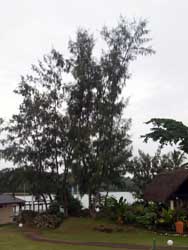 Work in agroforestry is diverse and includes:
Work in agroforestry is diverse and includes:
Farmers looking to improve the ecology on their properties whilst at the same time producing income from trees.
Research officers - working both nationally and internationally to research the best methods to improve economic and environmental aspects of agroforestry.
Agroforestry professionals working in under-developed countries to improve economic and environmental situations.
WHAT IS AGROFORESTRY?
This is the activity of integrated agricultural and forestry production. Trees become multi- functional, acting as a resource to be harvested in the future, and as an asset for the existing farm.
There is currently very strong interest in the development of timber plantations on farms for a variety of purposes. These include:
-
They can be used for firewood ensuring that it remains a renewable resource.
-
They reduce the need for harvesting (both timber and firewood) in state forests. It is hoped that eventually plantations will be able to provide much or all of Australia's timber and firewood needs.
-
Trees use up and store a lot of carbon-dioxide from the atmosphere, particularly in their earlier years when growth is most active (they act as a carbon "sink"). This helps counteract the release of carbon dioxide and other gases during burning of wood and other materials (i.e. fossil fuels).
-
The plantations provide increased opportunities for wildlife habitat. Such plantations can also be used to link remnant vegetation patches, allowing increased opportunities for migration, feeding and breeding. Stock animals also may benefit from the shelter provided by these trees.
-
The plantations can help offset or minimise the effects of land degradation problems such as soil erosion and salinity. Marginal land (e.g. degraded, waterlogged, steep) can often be turned into very productive land. Water logging can also be reduced in the immediate area of established trees. Plantations can also be designed to provide useful windbreak effects.
-
Such plantations offer significant long term financial benefits to plantation owners. It can be a case of literally planting and growing your own retirement benefits, or of providing income for your children or grandchildren. They can provide significant alternative sources of income for farmers, particularly if harvested when returns from other farm activities are down. Thinnings harvested as the plantation matures can also provide some return to the farmer, prior to final harvesting. With careful selection of tree and associated under storey species, they can also become a source of fodder for the animals (eg. tagaste, carob, salt-bush).
The functional layout of tree specimens usually will depend on the site or farm plan, the species being used and the future use of the tree species. Common arrangements include wide spacing (eg 10m x 10m grid spacing); spiral; narrow belts; clumps/clusters; wood-lots.
Shelter belts, common on farms, usually run along the perimeter of the farm lot. Evidence exists that crops placed within the 1.5H zone (a distance out from the edge of the shelter belt equivalent to 1.5 times the height of the shelter belt) is where the crop may suffer the greatest due to competition for water and nutrients. Between 1.5H and 9H, the crops tend to show the greatest protection benefit. Crops placed out beyond 9H showed the effects of reduced protection from the shelter belt and consequently lower yields.
Some protection can be obtained as far as 15H - 20H downwind of the shelter belt.
Even if as little as 5% of the farm is devoted to a shelter network, the profitability of the farm will likely be increased in the long term. The high costs of harvesting the tree species can be problem if timber sales do not offset harvesting costs. Careful selection of species grown, and subsequent management, is important to ensure that the crop produced is as economically valuable as possible. In many cases it may be decided the environmental benefits of retaining any plantings outweighs returns from harvesting.
The economic viability of agroforestry will therefore depend on the timber species used:
-
growth rate
-
suitability to soil and district
-
demand and yield profit for the timber
-
maintenance of the forest species
-
agricultural production:
-
animal or plant species
-
compatibility to soil, climate, timber species
-
management practices
-
demand and yield profit based on production
-
impact of the plants and animals on the tree plantings and vice versa.
Agrofrestry Maintenance:
Trees will need to be pruned predominantly for the following reasons:
-
to maintain high quality valued timber
-
maintain access for animals and machinery
-
reduce potential wind damage
-
reduce shade to the ground which would reduce growth of pasture grasses
-
to supply fodder for animals
Tree Selection
As each site carries with it a range of characteristics, it is important to identify those tree species most suitable for that site. Species that may be perfect for one farm may not be the same species for another farm 10 kilometres away - the soil features may alter, climate may actually vary, etc.
Relevant Courses include Trees for Rehabilitation and Australian Native Trees